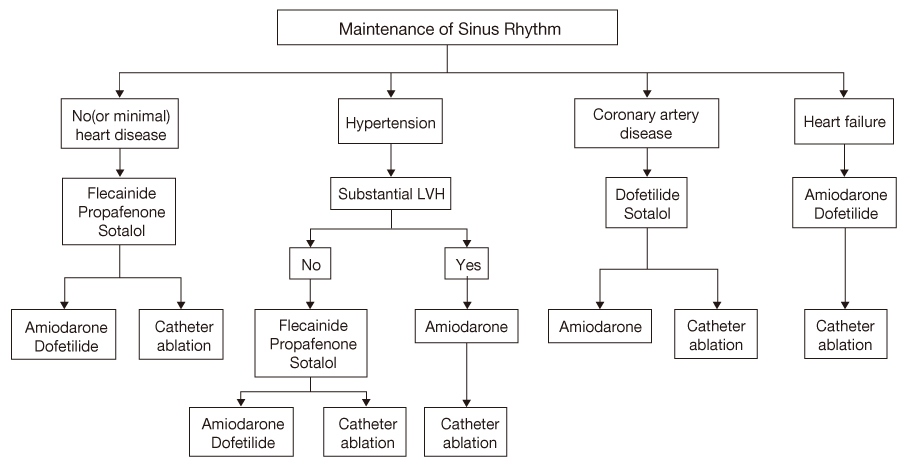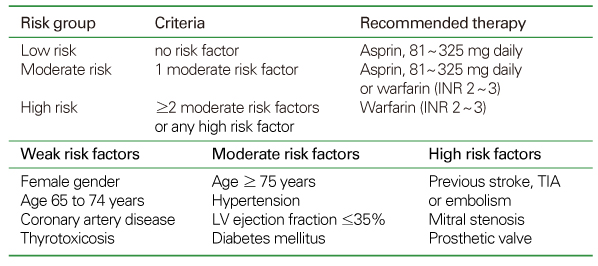 |
 |
- Search
| J Korean Med Assoc > Volume 53(3); 2010 > Article |
Abstract
Cardiac arrhythmia is regarded as one of the three major cardiovascular diseases. For treatment, non-pharmacologic therapy such as antiarrhythmic device implantation and catheter ablation is frequently used. In this article, recent advancement in the management of the cardiac arrhythmia including pacemaker therapy for bradycardia, drug therapy and catheter ablation of atrial fibrillation, implantable cardioverter-defibrillator therapy for ventricular arrhythmia and sudden cardiac death, and cardiac resynchronization therapy for drug refractory heart failure with ventricular dyssynchrony will be reviewed. I hope this review can be of help for the health care providers in clinical fields.
References
1. ACC/AHA/HRS 2008 Guidelines for Device-Based Therapy of Cardiac Rhythm Abnormalities: a report of the American College of Cardiology/American Heart Association Task Force on Practice Guidelines. Circulation 2008;117:e350-e408.
2. Sweeney MO, Prinzen FW. A new paradigm for physiologic ventricular pacing. J Am Coll Cardiol 2006;47:282-288.
3. Connolly SJ, Kerr CR, Gent M, Roberts RS, Yusuf S, Gillis AM, Sami MH, Talajic M, Tang AS, Klein GJ, Lau C, Newman DM. Effects of physiologic pacing versus ventricular pacing on the risk of stroke and death due to cardiovascular causes. Canadian Trial of Physiologic Pacing Investigators. N Engl J Med 2000;342:1385-1391.
4. Lamas GA, Lee KL, Sweeney MO, Silverman R, Leon A, Yee R, Marinchak RA, Flaker G, Schron E, Orav EJ, Hellkamp AS, Greer S, McAnulty J, Ellenbogen K, Ehlert F, Freedman RA, Estes NA 3rd, Greenspon A, Goldman L. Mode Selection Trial in Sinus-Node Dysfunction. Ventricular pacing or dual-chamber pacing for sinus-node dysfunction. N Engl J Med 2002;346:1854-1862.
5. Sweeney MO, Shea JB, Fox V, Adler S, Nelson L, Mullen TJ, Belk P, Casavant D, Sheldon T. Randomized pilot study of a new atrial-based minimal ventricular pacing mode in dual-chamber implantable cardioverter-defibrillators. Heart Rhythm 2004;1:160-167.
6. Parekh S, Stein KM. Selective site pacing: rationale and practical application. Curr Cardiol Rep 2008;10:351-359.
7. ACC/AHA/ESC 2006 Guidelines for the Management of Patients with Atrial Fibrillation. Circulation 2006;114:e257-e354.
8. Hohnloser SH, Crijns HJ, van Eickels M, Gaudin C, Page RL, Torp-Pedersen C, Connolly SJ. ATHENA Investigators. Effect of dronedarone on cardiovascular events in atrial fibrillation. N Engl J Med 2009;360:668-678.
9. HRS/EHRA/ECAS Expert Consensus Statement on catheter and surgical ablation of atrial fibrillation: recommendations for personnel, policy, procedures and follow-up. A report of the Heart Rhythm Society (HRS) Task Force on catheter and surgical ablation of atrial fibrillation. Heart Rhythm 2007;4:816-861.
10. Connolly SJ, Ezekowitz MD, Yusuf S, Eikelboom J, Oldgren J, Parekh A, Pogue J, Reilly PA, Themeles E, Varrone J, Wang S, Alings M, Xavier D, Zhu J, Diaz R, Lewis BS, Darius H, Diener HC, Joyner CD, Wallentin L. RE-LY Steering Committee and Investigators. Dabigatran versus warfarin in patients with atrial fibrillation. N Engl J Med 2009;361:1139-1151.
11. ACC/AHA/ESC 2006 guidelines for management of patients with ventricular arrhythmias and the prevention of sudden cardiac death. Circulation 2006;114:e385-e484.
12. ESC 2007 Guidelines for cardiac pacing and cardiac resynchronization therapy. Europace 2007;9:959-998.
- TOOLS
-
METRICS

-
- 1 Crossref
- Scopus
- 1,098 View
- 8 Download
-
Related articles in
J Korean Med Assoc -
Recent trends in the management of anterior knee pain2023 August;66(8)
Recent advances in the treatment of multiple myeloma2023 April;66(4)
Prevalence and treatment of pediatric dyslipidemia2021 June;64(6)
Recent Trend of Management Childhood Asthma1997 March;40(3)
Recent Trend in Treatment of Atopic Dermatitis1997 March;40(3)









